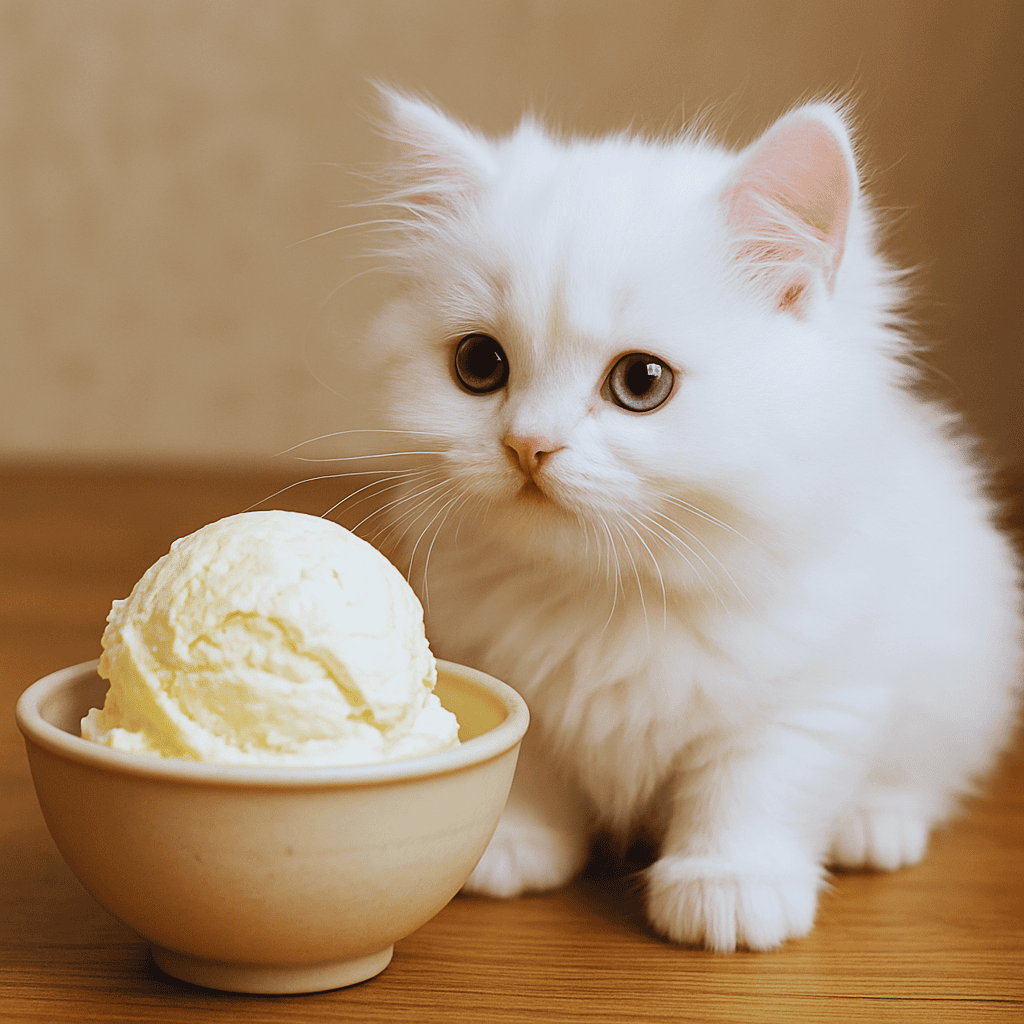It’s a hot day, and you’re enjoying a scoop of your favorite vanilla ice cream when your cat hops up beside you, giving you those pleading eyes. Can cats eat ice cream? Is a small lick harmless—or could it lead to tummy trouble? This article explores everything pet parents need to know about cats and ice cream, including potential risks, myths, safe alternatives, and real-world stories from cat owners.

Is Ice Cream Safe for Cats?
The short answer is no, ice cream is not recommended for cats, even though a small lick likely won’t cause serious harm. While it might seem like a fun, harmless treat, ice cream contains ingredients that don’t sit well with a cat’s digestive system.
Cats are obligate carnivores with very specific dietary needs. Ice cream doesn’t offer any nutritional benefit for them—and in some cases, it could make them sick.
Why Ice Cream Isn’t Ideal for Felines
Here’s why veterinarians and feline experts generally advise against giving your cat ice cream:
1. Lactose Intolerance
Many adult cats are lactose intolerant, which means they lack the enzyme needed to properly digest milk-based products. Ice cream is loaded with dairy, and even a few spoonfuls can lead to:
- Diarrhea
- Bloating
- Gas
- Stomach cramps
According to ASPCA’s guide on feline nutrition, milk and dairy can upset your cat’s digestive system even if they seem to enjoy it.
2. Sugar and Sweeteners
Ice cream is high in sugar, which cats don’t need and can’t taste. More importantly, xylitol, a common artificial sweetener in “sugar-free” ice cream, is toxic to pets—even in small amounts.
3. Fat and Calories
Too much fat can contribute to obesity, pancreatitis, or liver problems in cats. A single scoop of ice cream is very calorie-dense for a small pet.
What Happens if My Cat Eats Ice Cream?
If your cat sneaks a lick or two of plain vanilla ice cream, they’ll likely be fine. But watch for signs of digestive upset over the next 12–24 hours, including:
- Vomiting
- Loose stool
- Lethargy
- Decreased appetite
If symptoms persist, contact your vet. For emergencies, PetMD’s guide on pet poisoning symptoms can help identify more severe reactions.
Which Ingredients Are Problematic?
Some ingredients found in human ice cream can be especially harmful to cats:
| Ingredient | Risk Level | Why It’s Bad |
|---|---|---|
| Chocolate | High | Contains theobromine (toxic) |
| Raisins | High | Can cause kidney failure |
| Xylitol | Very High | Potentially fatal for pets |
| Coffee/espresso | High | Contains caffeine (toxic) |
| Nuts | Moderate | High in fat and choking risk |
When in doubt, avoid sharing any flavored ice creams with your cat, especially those with mix-ins or artificial additives.
Can Cats Eat Dairy-Free Ice Cream?
Lactose-free or dairy-free ice cream sounds like a safer option—but it’s not automatically cat-safe. Many of these products still include:
- Artificial sweeteners
- Coconut milk (which can cause diarrhea)
- Chocolate or other harmful flavorings
If you really want to share a frozen snack with your feline, it’s better to make your own (we’ll get to that in a bit!).
Safe Frozen Treat Alternatives for Cats
While traditional ice cream is off the menu, that doesn’t mean your cat can’t enjoy a chilled treat. Here are some safer and healthier frozen options:
1. Frozen Tuna Cubes
Blend tuna in water and freeze in silicone trays. These are hydrating, fishy, and fun!
2. Chicken Broth Pops
Use unsalted, onion-free chicken broth and freeze it in small amounts. Let it melt slightly before offering.
3. Yogurt Drizzle (for some cats)
A tiny amount of plain, unsweetened Greek yogurt can be tolerated by some cats. Try freezing a small swirl.
Always test new foods in tiny amounts and monitor your cat’s reaction.
Real Owner Experiences
“My tabby, Luna, snuck a bit of my vanilla cone once. She seemed fine but had gas later that night—lesson learned! Now I just make tuna ice cubes for her when it’s hot.”
— Amy T., Dallas, TX
“Most pet owners don’t realize just how sensitive cats can be to dairy and sugar. I used to think a lick of whipped cream was harmless. My vet definitely set me straight.”
— Tom R., Seattle, WA
Sharing is caring, but it’s better to do it with treats made specifically for your cat’s needs.
FAQ
Can cats have a small lick of ice cream?
Technically yes, but it’s not recommended. Most cats are lactose intolerant, and it can upset their stomachs.
Is vanilla ice cream safe for cats?
Plain vanilla is less dangerous than chocolate or coffee, but it still contains dairy and sugar—not good for cats.
What happens if my cat eats chocolate ice cream?
Chocolate is toxic to cats. Call your vet or a poison control hotline immediately if this happens.
Are there any safe ice cream brands for cats?
Some specialty pet stores sell frozen treats made for cats. Look for products made with fish, chicken broth, or goat’s milk—always read the label.
How can I cool my cat down in summer?
Offer cold water, frozen tuna cubes, and shaded areas. Never use fans pointed directly at your cat, as they don’t sweat like humans do.
Final Thoughts
So, can cats eat ice cream? While a single lick likely won’t send your cat to the emergency vet, it’s far from a healthy treat. Most ice cream is packed with sugar, dairy, and sometimes toxic ingredients.
Instead of sharing your human dessert, consider making a frozen feline-friendly snack or buying cat-safe treats designed with their health in mind.
Want more DIY ideas or safety tips for hot weather? Head over to fluffze.com and explore our library of homemade pet food guides.
Call-to-Action
Found this helpful? Share it with fellow cat lovers, and follow Fluffze for more trusted pet parenting tips.
Written by Author Box
Written by Shawn, pet lover & contributor at Fluffze
Related Articles:
Can Cats Eat Blueberries? A Safe & Tasty Guide for Cat Parents
Dangerous Foods Cats Should Not Eat
Can Cats Eat Raw Fish? Expert Advice





